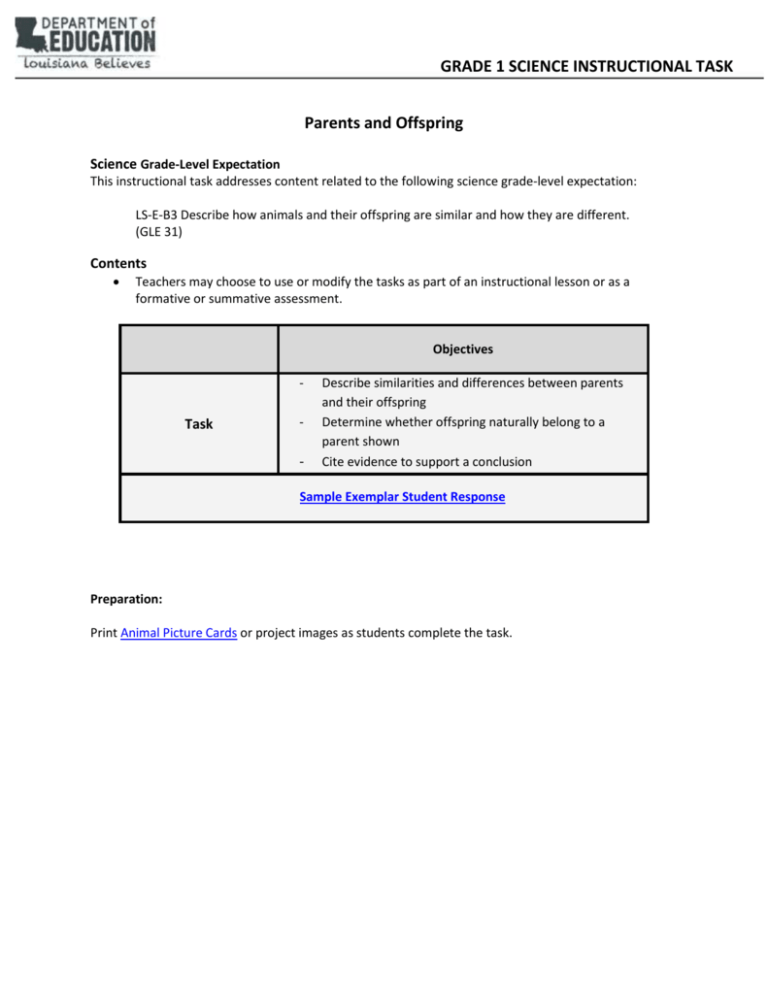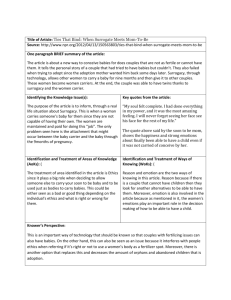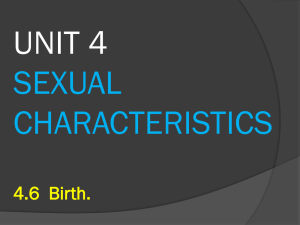Task - Science - Grade 1
advertisement

GRADE 1 SCIENCE INSTRUCTIONAL TASK Parents and Offspring Science Grade-Level Expectation This instructional task addresses content related to the following science grade-level expectation: LS-E-B3 Describe how animals and their offspring are similar and how they are different. (GLE 31) Contents Teachers may choose to use or modify the tasks as part of an instructional lesson or as a formative or summative assessment. Objectives - Task - - Describe similarities and differences between parents and their offspring Determine whether offspring naturally belong to a parent shown Cite evidence to support a conclusion Sample Exemplar Student Response Preparation: Print Animal Picture Cards or project images as students complete the task. Task – Part A Look at the pictures given to you by your teacher. Fill out the chart with two ways the parent and its offspring are similar and two ways they are different. Similarities Differences 1- Opossums 2- Rhinoceros 3- Penguins 4- Anteaters Look at your observations above. Describe the overall similarities and differences between these parents and their offspring. ______________________________________________________________________________ ______________________________________________________________________________ ______________________________________________________________________________ Task – Part B Look at the pictures given to you by your teacher. Fill out the chart with two ways the parent and its offspring are similar and two ways they are different. Similarities Differences 5- Butterflies 6- Frogs 7- Mosquitos Look at your observations above. Describe the overall similarities and differences between these parents and their offspring. ______________________________________________________________________________ ______________________________________________________________________________ ______________________________________________________________________________ Task – Part C Look at the picture above. Is one of these animals the natural parent of the other? Write at least 2 pieces of evidence to support your answer. One animal (is / is not) the natural parent of the other. _________________________________ ______________________________________________________________________________ ______________________________________________________________________________ ______________________________________________________________________________ Sample Exemplar Student Response: Part A Similarities Differences 1- Opossums Gray and white coloring Rounded ears Parent is bigger Baby tails are longer and skinnier 2- Rhinoceros Rough grey skin Eyes on the side of their head Baby has no horn Baby’s skin a little smoother Similar body shape Wings and a beak 3- Penguins Soft down on babies, feathers on parent Babies have more grey coloring, parent has dark black 4- Anteaters Long noses Hair covering body Baby is darker in color Baby has white toenails; mother has dark toenails Some babies look just like their parents. The baby opossum has the same coloring and body parts. Other babies look a little different than their parents. For example, the rhinoceros baby does not have a horn yet. Penguin babies don’t have feathers yet. But when they become an adult, they will look almost exactly like their parent. Part B Similarities Differences 5- Butterflies Black and white coloring Antennae Parent has wings Baby crawls on many legs 6- Frogs Green in color Long, oval bodies Tadpole has tail Frog has four legs 7- Mosquitos Spikes on body Segmented body parts Parent has wings Baby swims in water Some babies do not look very much like their parents. The caterpillar has similar black and white coloring and has an antennae like the butterfly. But the caterpillar has one long body and crawls and the butterfly has two wings and can fly. The tadpole is green like the frog but lives in water. A mosquito also starts as a baby in water. Then it grows up and can fly like the butterfly. All the babies have something like their parents, but they are very different too. Part C One animal is not the natural parent of the other. They both have fur, but the fur is soft and smooth on the bunny. The lamb has curly thick hair in a different color. They both have long ears and four legs, but one has long legs and the other has shorter legs. A rabbit will have baby bunnies that look like the adult rabbit. The baby lamb comes from a sheep, not a rabbit. Animal Picture Cards 1 2 3 4 5 6 7






